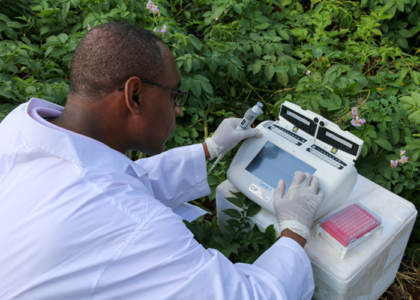
With an ability to produce more food per hectare than most crops, the potato has great potential to contribute to Africa’s expanding food needs. But that potential is all too often cut short by pathogens and pests that decimate potato yields across the region.
Global average potato yield is around 21 tons per hectare, and some farmers in Europe and North America harvest more than 40. But farmers in sub-Saharan Africa (SSA) produce an average of about eight tons of potatoes per hectare, and the principal cause of that yield gap is disease. According to a survey of potato experts in 10 SSA countries in 2018, the most serious threat to the region’s potato crop is bacterial wilt disease. Caused by the soil- and seed-borne bacteria Ralstonia solanacearum – a high-risk, quarantine pathogen in Europe and the Mediterranean – bacterial wilt is responsible for an estimated USD 1 billion of economic loss globally each year, largely because of eradication measures and restrictions imposed on contaminated farmland.
“Bacterial wilt is a difficult disease to manage,” says Kalpana Sharma, a scientist with the International Potato Center (CIP) who has led studies of its prevalence in several African countries that confirmed its considerable spread. She notes that whereas potato farmers commonly control other diseases (such as late blight) by spraying fungicides on their fields, there is no comparable agrochemical option for bacterial wilt management.
Pernicious pathogen
While Ralstonia solanacearum infects an array of crops and wild plants, it poses an acute threat to potato because it is spread by infected seed tubers. Irrigation water, rain runoff, farmers’ tools and boots and livestock can also carry the bacteria into uninfected fields. And, to make things worse, those bacteria can survive in the soil for years.
The bacteria enter plants via the roots and multiply inside, creating a white slime that clogs their vascular systems, and causes their leaves to wilt for lack of water. Leaf wilting is the first symptom of bacterial wilt, but as infection grows, the slime may ooze out of a potato’s eyes, or from cuts in the tuber or stem. Though harmless to people, the bacteria create brown spots in tubers and causes them to rot quickly, making them unsuitable for consumption.
“Once established in a potato plot, the disease can cause 40 to 100 percent yield loss, which makes preventing its introduction into new areas a priority,” says Sharma.

Seed system solutions
To reduce yield loss from seed-borne diseases, CIP promotes the establishment of formal systems that produce and disseminate disease-free seed. However, most African farmers plant potatoes they purchase from informal markets or save from their own harvests, which perpetuates low yields.
To help government authorities and seed potato producers keep infected potatoes out of the seed supply, CIP is promoting the use of a technology called loop-mediated isothermal amplification (LAMP) to detect latent Ralstonia infections. LAMP uses specifically designed primers to quickly diagnose an array of pathogens that affect plants, animals or people – from sweetpotato viruses to COVID-19. And because the technology is field deployable, it increases the efficiency and accessibility of diagnostics.
“There is a lack of cost-effective, reliable and fast tools for bacterial wilt diagnosis in the government agencies of most potato producing countries in sub-Saharan Africa,” says Sharma. “And they also lack the capacity and training to use them.”
She explains that CIP has published a manual on using LAMP to detect bacterial wilt and begun training people in government and the private sector how to test potatoes, plants, or soil for the bacteria using LAMP and other diagnostic tools. She adds that CIP is promoting the use of LAMP by private companies, which can offer diagnostic services to government, seed companies and large-scale farmers.
“There is no silver bullet for bacterial wilt,” observes Sharma. “Controlling it requires integrated strategies.”
She explains that those strategies include assessing the bacteria’s presence in potato producing areas and genetic analysis to determine which strains are prevalent, since some strains are more virulent than others. Understanding the distribution of those strains can contribute to more effective investments in regional management of the disease, and can help potato breeders develop resistant or tolerant varieties.
According to Sharma, educating farmers and decision makers about threat severity and management options is vital. While it may be impossible to eliminate the bacteria once it has infested a field, various on-farm practices (e.g., removing or burning infected plants, crop rotation) can reduce the disease’s destruction and the risk of spread. CIP has produced brochures and a video to educate farmers about the disease and best management practices.
“Contagious Ralstonia strains are likely being disseminated and exchanged across East African borders within informal potato trade channels among those countries,” warns Sharma. “In the absence of potato seed certification and regional quarantine measures, bacterial wilt will become an increasingly serious problem and threaten the region’s rapidly expanding potato industry.” The solution, Sharma says, is an integrated seed health strategy that combines resistant varieties and pathogen-free seed to safeguard potato production and food security for millions of smallholder families.
Funding for this work was provided by the German Federal Ministry for Economic Cooperation and Development.
